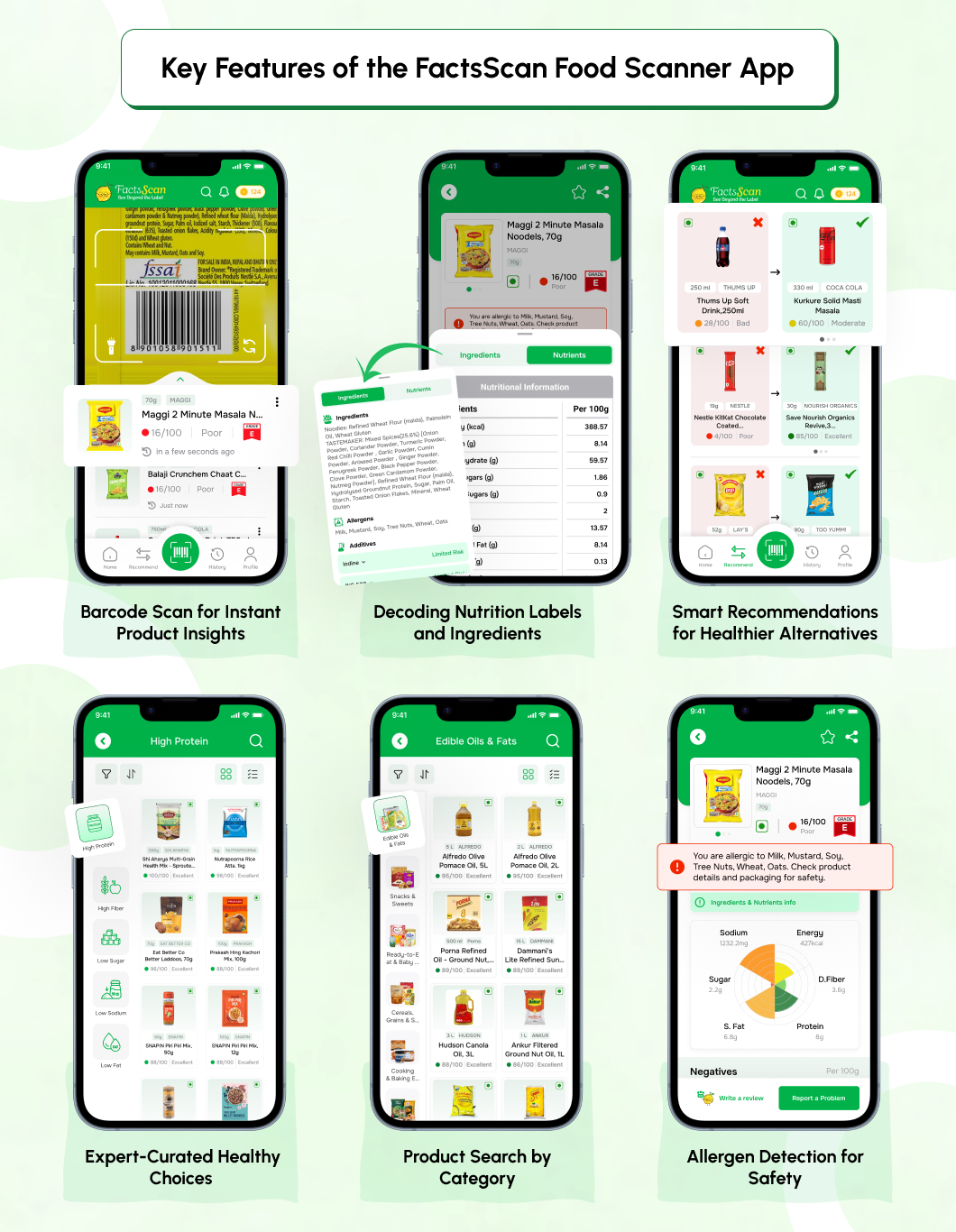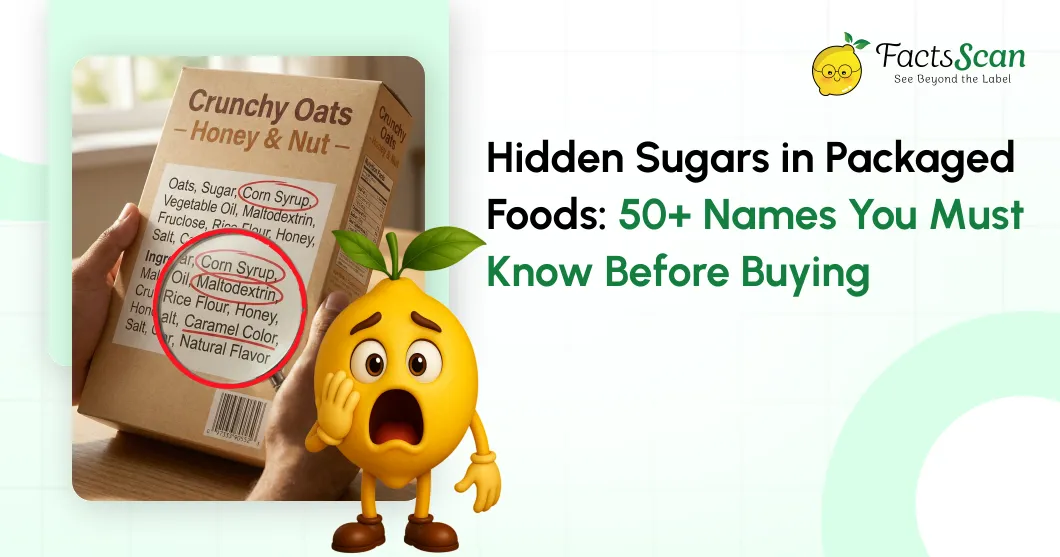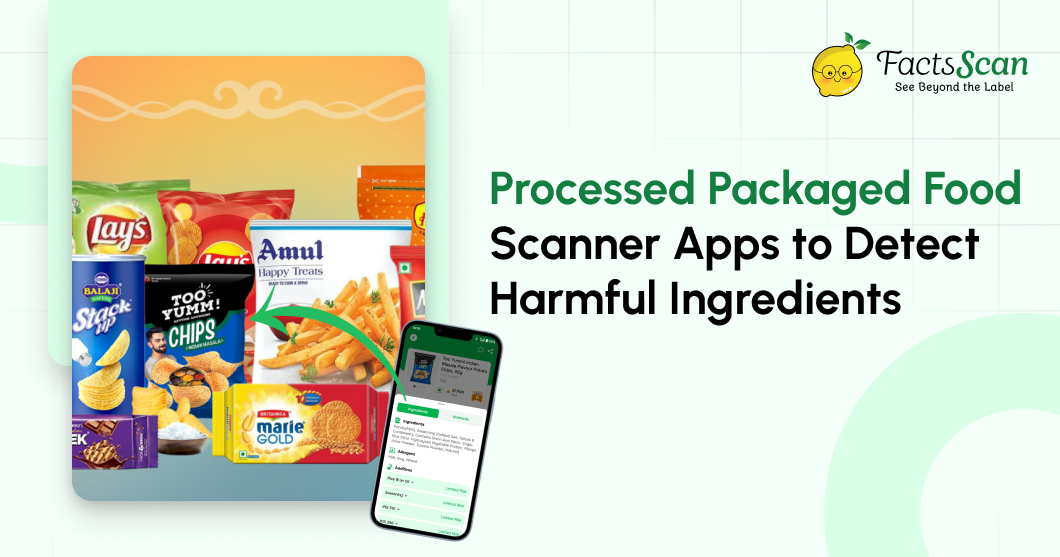Processed Packaged Food Scanner Apps to Detect Harmful Ingredients
Summary :
Processed packaged food scanner apps help you instantly detect harmful ingredients like excess sugar, unhealthy fats, and additives. Just scan a barcode to get healthier alternatives and make smarter food choices in seconds.
Ever stood in a supermarket aisle, staring at the cryptic food label on your favorite snack, and wondered what all those chemical names and “E-numbers” mean? You’re far from alone! With the explosion of ready-to-eat packaged foods in our lives, many shoppers are now more cautious about what goes inside those shiny wrappers. We crave convenience, flavor, and fun, but also want assurance that our choices won’t harm our health in the long run.
Yet, the simple act of reading a label often turns into a confusing exercise. Many ingredients sound more at home in a chemistry textbook than in our daily meals: mono- and diglycerides, sodium benzoate, artificial colors like E133, and preservatives with intimidating labels. It’s overwhelming, and most of us don’t have the time, much less the expertise to research every single component while grabbing groceries.
That’s where technology saves the day! Enter the world of processed packaged food scanner apps, blending artificial intelligence with vast nutrition databases to decode those labels instantly. With just your smartphone camera and a couple of taps, you can get a simple, easy-to-understand breakdown, spot hidden dangers, and choose healthier options without the stress. Let’s explore how food scanner apps like FactsScan are revolutionizing food shopping turning every consumer into a label-reading pro.
The Problem with Processed Packaged Foods
Take a moment and scan the shelves in any supermarket or convenience store. Packaged snacks, beverages, instant noodles, frozen meals the options seem endless, and the marketing is irresistible. But look closer, and a different story emerges behind those alluring packages.
Let’s break down a few of the most concerning ingredients frequently found in processed packaged foods:
1. Palm Oil: Used for its affordability and shelf-stability, palm oil is now present in about half of all packaged food products globally. While it’s plant-based, palm oil is nearly 50% saturated fat, much higher than healthier alternatives like olive or canola oil. Its consumption has been associated with raising bad cholesterol (LDL) and increased risk for heart disease. There’s also the issue of sustainability, as palm oil cultivation is linked with significant environmental damage.
2. Trans Fats (Partially Hydrogenated Oils): Trans fats rank among the most harmful ingredients in processed foods. Found in baked goods, microwave popcorn, chips, and margarine, they increase LDL (“bad”) cholesterol, lower HDL (“good”) cholesterol, and contribute to arterial blockage. High intake is directly linked to higher rates of heart attack and stroke. Many countries have banned trans fats, but they still sneak into products under various aliases.
3. High Sugar and High Fructose Corn Syrup: Sweetness is often a sign of trouble. Excessive sugar and syrups hidden in sodas, flavored yogurts, cereals, and sauces fuel obesity, diabetes, and even metabolic syndrome. Hidden sugars appear under names like dextrose, maltose, or invert sugar, making it hard to track total sugar load.
4. Excess Salt and Sodium: Packaged meals and snacks are notorious for packing huge amounts of sodium often over half your daily recommended intake. While sodium is essential, excessive consumption raises blood pressure, strains the heart, and leads to hypertension and related complications.
5. Artificial Colors and Preservatives: Scientific studies have linked some artificial food colorings to behavioral changes in children, allergies, and, in extreme cases, increased cancer risk. Preservatives like sodium benzoate, BHA, and BHT are used to prolong shelf life but can spark allergies or even disrupt hormonal balance. Often, these additives are hidden deep in ingredient lists, labeled with numbers or chemical codes that the average consumer may not recognize.
6. Flavor Enhancers and Emulsifiers: Modern packaged foods often feature additives such as monosodium glutamate (MSG), artificial flavorings, and emulsifiers to improve texture and taste. While they can make food more enjoyable, some people experience headaches, allergies, or digestive discomfort.
7. Hidden Allergens: For those with food allergies, packaged foods can be a minefield. Trace peanuts, gluten, dairy, or soy can slip into products, sometimes under unexpected names or due to cross-contamination in manufacturing.
Why do these ingredients persist in our food supply? The answer is simple: they help manufacturers lower costs, improve texture, extend shelf life, and boost sales with intense flavors. The real challenge, however, is that many additives hide under unfamiliar names, buried in small print that’s nearly impossible to decipher during a quick shop.
The Consumer Challenge: Reading & Understanding Food Labels
Let’s be honest: few people have the time, patience, or background knowledge to decode every food label. The process is time-consuming, frustrating, and easy to get wrong. Marketing teams use buzzwords like “natural,” “healthy,” and “low fat,” often overshadowing the real nutritional risks inside.
Most consumers:
- Struggle to recognize hidden sugars, fats, or chemical additives in ingredient lists
- Feel overwhelmed by complex nutrition tables
- Miss risky allergens or unsafe preservatives
- Make decisions based on price, taste, or branding rather than health
This confusion is compounded in India, where thousands of local and regional brands sell products with varying standards of labeling clarity. For families managing chronic illnesses, allergies, or dietary restrictions, the stakes are even higher.
What Are Processed Packaged Food Scanner Apps?
Key Features of the FactsScan Food Scanner App

There’s no shortage of scanner apps in the market, but the best ones stand out for a handful of crucial features. If you want to benefit most from your food scanning experience, look for apps (like FactsScan) that offer:
1. Barcode Scan for Instant Product Insights
Forget struggling with tiny print! With a simple scan, the app brings up a product’s full profile, including nutritional facts, hidden additives, and allergen alerts. Fast, accurate, and user-friendly.
2. Decoding Nutrition Labels and Ingredients
Food labels often use scientific names or codes for additives. The right app will translate “sodium benzoate” or “E133” into plain English and clearly signal potential health risks associated with these ingredients.
3. Smart Recommendations for Healthier Alternatives
If your favorite snack gets a low health score, you don’t have to guess what else to buy. Top apps suggest instant, better-for-you options, so you always have a healthy swap at hand.
4. Expert-Curated Healthy Choices
Ratings and recommendations backed by nutritionists give you confidence that grades aren’t just algorithm-driven—they’re grounded in medical science and dietary expertise.
5. Product Search by Category
No barcode? No problem! Browse categories like “breakfast cereals,” “snacks,” or “ready meals” for vetted, healthy picks.
6. Allergen Detection for Safety
For families with allergies, apps are truly lifesaving. They flag top allergens and help you avoid accidental exposures, even providing information about potential cross-contamination.
How FactsScan Helps Detect Harmful Ingredients
Let’s walk through an example of how FactsScan, a leading scanner app, works in practice:
Step 1: Open FactsScan when you enter the store.
Step 2: Scan the barcode on any packaged food item—say, a potato chip packet.
Step 3: The app immediately pulls up a detailed analysis:
- Nutrients: Calories, total fat, saturated fat, trans fat, sugar, salt, fiber
- Ingredients: Each component explained; artificial colors and preservatives flagged in red
- Allergens: Alerts for gluten, nuts, dairy, soy, etc.
- Health Grade: Simple A–E system—A
Conclusion
In today’s fast-paced world, it’s easy to grab whatever snack or meal fits your cravings. But it’s even easier to overlook the hidden dangers inside those colorful packets. From palm oil to artificial colors, unhealthy ingredients lurk in everyday foods—and the long-term impact on your health is real.
The good news? You no longer have to be a nutrition expert or spend hours researching food labels. With FactsScan, your smartphone becomes your personal food detective—scanning products, exposing harmful ingredients, alerting you to allergens, and guiding you toward healthier options in seconds.
Your health is in your hands—literally.
Next time you’re in the supermarket, don’t just pick a product because it looks tasty or says “healthy” on the pack. Scan it. Check it out. Choose wisely.
Ready to make Healthier Choices?
Download FactsScan now from the Google Play Store and App Store and take charge of your food choices.

Recent Articles

Hidden Sugars in Packaged Foods: 50+ Names You Must Know Before Buying
Uncover the shocking truth about hidden sugars lurking in everyday packaged foods. Learn why manufacturers add them, understand the serious health risks, and master the skill of identifying over 50 disguised sugar names on ingredient labels to protect your health.

How to Identify Organic Food in India: A Complete Consumer Guide
Discover how to confidently identify genuine organic food in India. Learn about certifications, label reading, and effective ways to verify authenticity using simple, actionable steps for your everyday shopping.

Top Food Ingredients You Should Avoid for Better Gut Health
Your gut microbiome is the foundation of your overall wellness, affecting everything from digestion to immune function. Yet many everyday food ingredients—artificial sweeteners, refined oils, emulsifiers, and preservatives—are slowly damaging this delicate ecosystem. Learn which harmful ingredients to eliminate from your diet and discover healthier alternatives using smart tools to identify nutritious, gut-friendly options that truly support your digestive health and long-term wellbeing.
 20 Aug 2025
20 Aug 2025 8 Min Read
8 Min Read 







